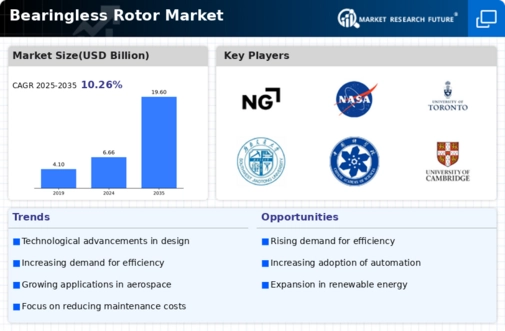Technological Advancements
The Global Bearingless Rotor Market Industry is experiencing rapid technological advancements that enhance rotor performance and efficiency. Innovations in materials and design methodologies allow for the development of rotors that are lighter and more durable. For instance, the integration of composite materials has led to a reduction in weight while maintaining structural integrity. This trend is significant as it aligns with the industry's shift towards more energy-efficient solutions. As a result, the market is projected to reach 6.66 USD Billion in 2024, reflecting the growing demand for advanced rotor technologies across various applications.
Rising Industrial Automation
The trend towards industrial automation is reshaping the Global Bearingless Rotor Market Industry. Industries are increasingly adopting advanced rotor technologies to improve operational efficiency and reduce downtime. Bearingless rotors, with their reduced maintenance requirements, are particularly appealing in automated environments where reliability is paramount. As industries seek to optimize production processes, the integration of bearingless rotor systems is likely to become more prevalent. This shift not only enhances productivity but also aligns with broader trends in smart manufacturing, suggesting a promising outlook for the market.
Market Trends and Projections
Increasing Demand in Aerospace
The aerospace sector is a major driver of the Global Bearingless Rotor Market Industry, as the need for high-performance rotors in aircraft continues to rise. The aviation industry is increasingly adopting bearingless rotor systems due to their ability to reduce maintenance costs and improve fuel efficiency. This trend is underscored by the projected growth of the market, which is expected to reach 19.6 USD Billion by 2035. The shift towards more sustainable aviation practices further propels the demand for innovative rotor solutions, indicating a robust growth trajectory for the industry in the coming years.
Growing Renewable Energy Sector
The expansion of the renewable energy sector significantly influences the Global Bearingless Rotor Market Industry. Wind energy applications, in particular, are increasingly utilizing bearingless rotor technologies to enhance turbine efficiency and reduce operational costs. As countries worldwide commit to reducing carbon emissions, the demand for efficient wind turbines is likely to surge. This trend is expected to contribute to a compound annual growth rate of 10.3% from 2025 to 2035, highlighting the potential for bearingless rotor systems to play a crucial role in the transition to sustainable energy sources.
Regulatory Support for Advanced Technologies
Government regulations promoting advanced technologies are fostering growth in the Global Bearingless Rotor Market Industry. Many countries are implementing policies that encourage the adoption of innovative rotor systems, particularly in sectors such as aerospace and renewable energy. These regulations often focus on improving efficiency and reducing environmental impact, which aligns with the capabilities of bearingless rotor technologies. As regulatory frameworks evolve to support sustainable practices, the market is poised for expansion, with stakeholders likely to invest in bearingless rotor solutions to comply with emerging standards.


















